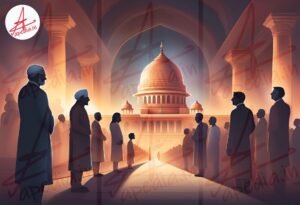The Constituent Assembly took nearly three years to draft the Indian Constitution, from 1946 to 1950.
- British parliamentary democracy
- American federalism
- Canadian provincial autonomy
- Other global constitutions
The Constitution was adopted on November 26, 1949, and came into effect on January 26, 1950.
Cabinet Mission Plan
The process of drafting the Indian Constitution began with the Cabinet Mission Plan of 1946. This plan, formulated by the British government, was crucial in setting out the framework for India’s transition from colonial rule to independence. The plan detailed the creation of a Constituent Assembly that would be responsible for framing the Constitution, ensuring a representative and participatory approach to nation-building.
Elections
To populate this Constituent Assembly, elections were conducted across various provinces and princely states. These elections were pivotal as they determined the composition of the Assembly, reflecting the diverse political and social fabric of India at the time. The Assembly members were elected by the provincial legislatures and represented a wide array of regional and community interests.
Composition
The Constituent Assembly was a body of remarkable diversity, comprising representatives from different provinces, princely states, and various communities. This inclusivity was crucial for ensuring that the Constitution would address the varied needs and aspirations of the Indian populace. The Assembly initially included 389 members, with representation based on population and special considerations for minority groups.
Constituent Assembly
The Constituent Assembly was the primary body tasked with drafting the Indian Constitution. Its role was to create a comprehensive legal framework that would establish the governance structure of the newly independent nation. The Assembly’s discussions and deliberations were marked by extensive debates, reflecting the democratic ethos of the process.
Committees
To manage the complex task of constitution-making, the Assembly established various committees, each focusing on different aspects of the Constitution. These committees were instrumental in addressing specific issues such as fundamental rights, state powers, and the structure of government. Each committee was composed of experts and representatives who provided detailed inputs and recommendations.
Draft Constitution
The Drafting Committee, led by Dr. B.R. Ambedkar, was central to the creation of the draft Constitution. Dr. Ambedkar, often hailed as the principal architect of the Indian Constitution, played a crucial role in shaping the document’s structure and content. The draft prepared by this committee was a result of rigorous discussions and revisions, reflecting the Assembly’s collective vision.
Discussions and Amendments
The draft Constitution was subjected to intense scrutiny and discussion by the Constituent Assembly. Members debated various provisions, proposed amendments, and made modifications to ensure the Constitution’s comprehensiveness and effectiveness. This iterative process was essential for addressing diverse viewpoints and achieving consensus.
Adoption
After thorough discussions and revisions, the Constitution was formally adopted on November 26, 1949. This adoption marked a significant milestone in India’s journey toward becoming a sovereign republic. The adoption was a ceremonial event that symbolized the culmination of years of preparation and negotiation.
Enactment
The Constitution came into effect on January 26, 1950, a date now celebrated as Republic Day in India. The enactment of the Constitution established the legal and institutional framework of the Indian Republic, officially inaugurating the new era of democratic governance.
Federal Structure
The Indian Constitution establishes India as a federal republic, delineating a clear division of powers between the central and state governments. This federal structure is designed to balance the distribution of authority and ensure effective governance across the country’s diverse regions.
Parliamentary Democracy
India operates under a parliamentary system of government where the executive is accountable to the legislature. This system ensures that the government remains responsive to the elected representatives of the people, upholding the principles of democratic accountability.
Fundamental Rights
- Right to Equality: Prohibits discrimination based on caste, religion, sex, or place of birth.
- Right to Freedom: Guarantees freedom of speech, expression, assembly, association, movement, and religion.
- Right to Life and Liberty: Ensures the right to life, personal liberty, and bodily integrity.
- Cultural and Educational Rights: Protects cultural and educational rights of minorities.
- Right to Constitutional Remedies: Provides remedies for violations of fundamental rights.
Directive Principles of State Policy
- Social and Economic Justice: Guides the government in promoting social welfare and economic equality.
- Secularism: Ensures the religious neutrality of the state.
- International Peace and Security: Promotes cooperation with other nations.
Fundamental Duties
Civic Responsibilities: Imposes obligations on citizens to contribute to nation-building.
Parliamentary Democracy
- Rule of Law: Ensures that the government is subject to the law.
- Separation of Powers: Divides power among the executive, legislature, and judiciary.
Federal Structure
- Dual Governance: Outlines the distribution of powers between central and state governments.
- Autonomy: Grants autonomy to states while ensuring unity.
Flexibility
The Indian Constitution is designed to be flexible, allowing for amendments to adapt to changing circumstances. This flexibility ensures that the Constitution can evolve in response to new challenges and societal changes while maintaining its core principles.
Amendments
Since its adoption, the Constitution has been amended numerous times. These amendments have addressed various issues, including changes in governance structures, social justice provisions, and administrative reforms. The amendment process reflects the Constitution’s capacity to accommodate evolving needs and priorities.
The formation of the Indian Constitution was a landmark achievement in India’s history. It established the legal and institutional foundation for the world’s largest democracy and continues to guide the nation’s governance and development.






